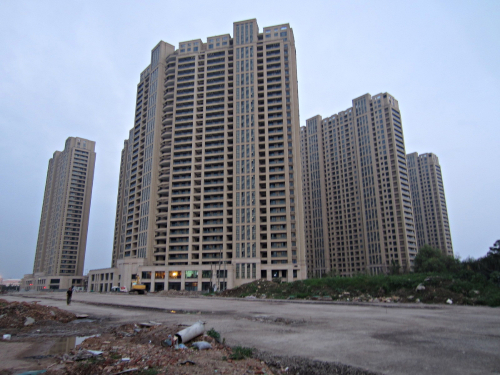|
 |
|
Newly built apartments in Huzhou, east China’s Zhejiang Province, in 2014 (BRIAN KUHL) |
Last summer, my wife and I returned to the small city of Huzhou in east China's Zhejiang Province for the first time in three years. At the end of our stay, we visited a Buddhist temple atop a small hill near the college where I'd taught. As we stood on the temple's veranda admiring the view of the sprawling city below us, an elderly nun came out of the courtyard and walked to one corner. Striking up a conversation with her, we learned that when the temple moved there about 20 years ago, the same view was mostly all farmland, with only a small city center in the distance. I couldn't imagine that.
In one of her articles published in the "Letter From Paris" column of The New Yorker magazine, late American journalist Janet Flanner wrote, "Old cities are monuments to themselves, not easily altered." Not so cities in China, many of which have changed dramatically in just the past decade or two. How should one keep up with the changes to physical landmarks, let alone emotional ones? This was something I faced when my "home away from home" morphed before my eyes.
Huzhou dates back to the third century B.C. and has long been famous for its silk and writing brushes. Before moving to the city in 2006, I had e-mailed another teacher there, who told me that, as a small city of under 1 million people, Huzhou had few modern attractions. It sounded perfect.
On my first morning there, on a cold February day, I walked from campus to the downtown area, passing mom-and-pop stores, six-story apartment buildings, and a canal that meandered through town. To warm up before heading back, I sat beside the canal in Dio Coffee--the only coffee shop I could find--and reflected on my luck in discovering such a livable place.
Huzhou was my home, off and on, for the next four and a half years. After three semesters, the winter cold I'd experienced that very first day sent me south. But I missed it immediately, and a year later I was back in my old job. I returned to find that major construction had begun downtown. Over the next few years, construction enveloped the entire city. The main public park, next to the Zhebei Mall, was closed and walled off for renovations; a whole block behind the mall and park was razed and rebuilt from the ground up; and one winter a long stretch of the Huancheng River vanished in the shadow of cranes and budding buildings.
Even on campus, a quieter area away from downtown, I was unable to escape. The college had profited handsomely from selling off part of its land to developers, who promptly tore down the athletic stadium to build apartment buildings. So when I left in 2011, it felt like it was time. A good thing had passed, I told myself; Huzhou was not the quiet place it once was. It was not only growing up but out, sprawling into nearby farmland. The city's character seemed altered.
When my wife and I arrived last summer to visit friends, many of the projects had been completed, transforming the city. The block behind the mall and park had become a gleaming new shopping area, complete with welcoming public plazas. Three Starbucks coffee shops had sprouted within one square km. But the biggest change was the site of the International Plaza, each of its twin towers rising 288 meters above the Huancheng River where I'd seen so much construction.
The new architecture wasn't all modern, however. An area of the canal downtown had been restored to look like an earlier era of two- and three-story traditional structures. A charming maze of shops, restaurants, teahouses, bookstores, and a museum surrounded a central path of paving stones. At night it pulsed with life. Strolling back to our hotel one evening, my wife and I peered through the windows of a hostel to see young Chinese and foreigners having fun playing a game.
So is change good or bad? Too fast a pace can be disorienting, and sometimes fond memories are all that remain of places now gone. But people are adaptable. A new generation is growing up in Huzhou, creating their own memories from new places. And change is a part of life--even, in a way, life itself. The old mill towns of New England, near where I now live, are a reminder of this as they sit stagnant and decrepit, frozen in time and seemingly near death.
On our visit to that temple last year, my wife and I eventually went into the courtyard after talking with the nun. We would leave the next day and, being nostalgic, I wanted to linger. We toured the temple's public spaces and took photos before departing. As we passed the nun, now sitting in a small wooden chair at a short distance, she looked up. We waved, and my wife said, "Zaijian (Goodbye)."
The author is an American who has lived in China
Copyedited by Eric Daly
Comments to yanwei@bjreview.com |
